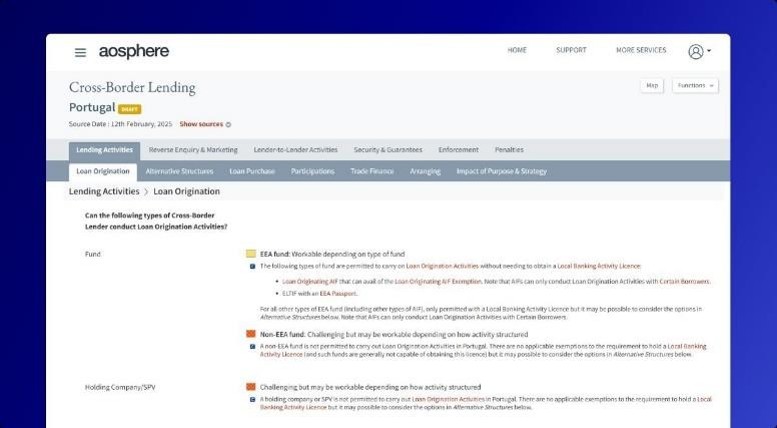In a climate of continued global economic volatility, rising operating costs and a drive towards increased regulation, firms and funds are having to be strategic about their distribution methods. Relying on reverse solicitation to access EU clients/borrowers may, at first glance, look attractive from a cost and administrative perspective. However, this continues to be an area of uncertainty and recent developments signal a policy shift at EU regulator level towards potential increased scrutiny, tighter reporting requirements and narrower circumstances for reliance.
In the following article we take a look at the parameters of reverse solicitation (where an EU client/borrower contacts a bank/firm/fund to express interest in its products or services), what lessons can be learned from its use in other areas of financial regulation for its application to lending activities and consider how market participants may mitigate their risks when acting in response to a reverse enquiry.
Legal basis for reverse solicitation
The concept of third country entities having the freedom to provide requested services at the exclusive initiative of the client has been acknowledged and expressly provided for by the European regulatory authorities for some time now, across several areas of financial regulation. When assessing the parameters for a permitted reverse enquiry, it is necessary to consider both the overriding EU legislation as well as each member state’s particular interpretation.
Commercial lending
Reverse enquiry in relation to banking/lending activities is currently in the spotlight in the EU as the new CRD package is due to be implemented over the course of the next 18 months or so. From January 2027, a new requirement for third country entities to at least establish a branch in the member state of the client to whom they are actively marketing/providing core banking services under CRD VI comes into force. However, this requirement only applies to active solicitation and is specifically stated not to apply where core banking services are requested at the exclusive initiative of the client. Whilst we wait to see if there will be any specific guidance released on the application of this reverse enquiry exemption, more generally, the following require careful consideration:
- frequency of use (given that reverse solicitation is generally understood to have limited value as a sustainable business model);
- how best to document reliance; and
- any particular nuances in interpretation made by each EU member state.
Investment services/activities
MiFID II provides for a specific reverse solicitation exemption from the investment services licensing
requirement for third country firms, where the EU client initiates “at its own exclusive initiative" the provision of investment services or activities. Any activities by a third country firm to solicit, promote or advertise its investment services or activities (regardless of the entity or method used) would negate the own exclusive initiative concept. A third country firm also cannot rely on the concept of reverse enquiry to market new categories of investment products or services to that client.
Fund distribution
The AIFMD does not expressly provide for a similarly specific reverse solicitation exemption, although from a read of recital 70 of the AIFMD (which states that the directive is not intended to affect professional investors who are investing in funds "on [their] own initiative") together with the AIFMD's definition of "marketing", it is expected that contacts initiated by investors are intended to be outside the scope of the AIFMD's marketing provisions.
The harmonisation of the pre-marketing of funds regime in Europe, brought into force in August 2021 by the cross-border distribution of funds (CBDF) package, also had an impact on the circumstances in which firms can rely on reverse solicitation. The CBDF directive included a provision which stated that any subscription to an AIF within 18 months of it having been pre-marketed in a particular jurisdiction is considered to be the result of active marketing and is subject to the applicable marketing passport notification procedures under the AIFMD. This means that there is effectively an 18-month restriction on relying on a reverse enquiry where the reverse enquiry relates to the units/shares of an AIF that was pre-marketed or that was established as a result of premarketing.
Member state interpretations
Aside from these provisions at an EU law level, the position on what constitutes a permitted reverse enquiry in a particular jurisdiction is often shaped by local market practice and/or the local regulator's guidance or tolerance levels, as opposed to being specifically provided for in national legislation. A bank/firm/fund wishing to respond to a reverse enquiry is therefore faced with diverging treatment of the concept of reverse solicitation (with the regulators of some jurisdictions such as Italy and France having a particularly strict interpretation of the concept). Despite this lack of homogeny, it is important to note that the general trend across the EU points towards construing reverse solicitation narrowly.
Tightening up of scope?
EU regulatory bodies have made some attempts over the years at clarifying and harmonising reverse solicitation practices, some of which are likely to influence the principles of future financial services legislation. Here are some examples:
- In its Q&A on investor protection and intermediaries under MiFID II, ESMA provided guidance on how the MiFID II reverse solicitation regime for third country firms should operate and specifically in what circumstances a client will be deemed to have acted on its “own exclusive initiative”.
- Further, amid concerns about questionable practices by firms relying on reverse solicitation for cross-border distribution of investment services in a post-Brexit climate, in January 2021 ESMA issued a statement warning against abuse of the MiFID II reverse solicitation regime and reminded firms of the conditions around permitted reverse enquiries. The kinds of practices identified were the use of generic clauses in terms of business or online pop-up consent boxes.
- In January 2022, ESMA published a letter it had sent to the European Commission in response to a call for evidence on the levels of reverse solicitation in the EU. ESMA flagged its difficulty in obtaining relevant information. However, for those jurisdictions where it was provided with data, it stated that the levels were high enough to raise concerns over the potential for reverse solicitation practices to circumvent licensing and registration requirements. As a result, ESMA suggested that the European Commission could consider contacting market participants (e.g. asset managers, depositories or account holders via national and European trade associations) directly to obtain information on reverse solicitation and also mentioned that it is considering the introduction of new reporting requirements allowing it to collect information on reverse solicitation across the EU.
- Most recently, in December 2024, ESMA issued guidelines aimed at addressing supervisory practice with regard to detecting and preventing the circumvention of the application of the Markets in Crypto-Assets Regulation (MiCA) to third country firms in the context of reverse solicitation which takes a stricter approach to what we had seen previously. Specifically in the context of MiCA, ESMA has determined that the concept should be interpreted very narrowly and is to be regarded as the exception, meaning that the area exempt from MiCA authorisation in which third country firms can operate based on reverse solicitation is significantly restricted. Although these guidelines focus exclusively on providing guidance for the MiCA reverse solicitation regime, they do indicate a direction of travel in terms of what the European supervisory authorities may tolerate in the future with regard to reverse solicitation practices, begging the question as to whether we will see a similar tightening of approach to permitted reverse enquiries beyond the scope of MiCA.
Tips for compliance
Although a jurisdiction-by-jurisdiction assessment is required, here are some best practice guidelines to bear in mind when responding to reverse enquiries from client in the EU:
- Scope: You should be clear on whether each transaction with a particular client/borrower needs to be preceded by a separate reverse enquiry and whether each reverse enquiry needs to relate to a specific product/service or whether it can be more general. Note that follow-up communications and meetings with previous clients/borrowers may not continue to fall outside the scope of relevant restrictions.
- Frequency: Generally speaking, the higher the number of reverse enquiries responded to, the greater the risk of being viewed as conducting active marketing/selling activities. In ESMA’s MiCA guidance, it states that whilst a large number of transactions based on reverse solicitation may be a good indication that there may be a breach of authorisation requirements, a number of transactions within a set cap would not ensure that such transactions are actually based on reverse solicitation. However, it is worth checking whether the target jurisdiction has set a maximum number of clients/borrowers to whom you may market/sell in response to a reverse enquiry.
- Evidence: It should be demonstrated that the request was genuinely unsolicited and made at the initiative of the client/borrower. This can often be done by keeping an audit trail of any communications and, in some cases, obtaining a written acknowledgement from the client/borrower.
- Cross-border versus onshore activities: In some jurisdictions, reverse enquiries can only be responded to from offshore, on a cross-border basis. You should check whether attendance at fly-in meetings or any onshore activities, even where requested by a client/borrower, will negate the reverse enquiry.
- Client/borrower type: Often reverse enquiries from less sophisticated clients/borrowers require more care. Also be aware that in some jurisdictions pre-existing relationships with a client/borrower may make it harder to prove the genuine nature of the reverse enquiry.
How aosphere can help
Our cross-border lending subscription service can help you navigate regulatory complexities by providing practical guidance on structuring cross-border lending activities, including taking security and assessing the enforcement regime.
Key features of the service include a useful comparison tool allowing you to compare across jurisdictions and regions, daily monitoring and email alerts and disclaimer language.






